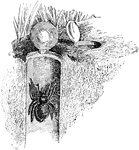Clipart tagged: ‘Anthropod’

Anthropod
This is a diagram illustrating the compound eye of anthropods. A, the whole eye shown in section; B,…

Trapdoor Spider
Spiders (order Araneae) are air-breathing chelicerate arthropods. Trapdoor spiders, of family Ctenizidae,…